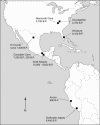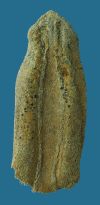An Asian origin for a 10,000-year-old domesticated plant in the Americas
- PMID: 16352716
- PMCID: PMC1311910
- DOI: 10.1073/pnas.0509279102
An Asian origin for a 10,000-year-old domesticated plant in the Americas
Abstract
New genetic and archaeological approaches have substantially improved our understanding of the transition to agriculture, a major turning point in human history that began 10,000-5,000 years ago with the independent domestication of plants and animals in eight world regions. In the Americas, however, understanding the initial domestication of New World species has long been complicated by the early presence of an African enigma, the bottle gourd (Lagenaria siceraria). Indigenous to Africa, it reached East Asia by 9,000-8,000 before present (B.P.) and had a broad New World distribution by 8,000 B.P. Here we integrate genetic and archaeological approaches to address a set of long-standing core questions regarding the introduction of the bottle gourd into the Americas. Did it reach the New World directly from Africa or through Asia? Was it transported by humans or ocean currents? Was it wild or domesticated upon arrival? Fruit rind thickness values and accelerator mass spectrometer radiocarbon dating of archaeological specimens indicate that the bottle gourd was present in the Americas as a domesticated plant by 10,000 B.P., placing it among the earliest domesticates in the New World. Ancient DNA sequence analysis of archaeological bottle gourd specimens and comparison with modern Asian and African landraces identify Asia as the source of its introduction. We suggest that the bottle gourd and the dog, two "utility" species, were domesticated long before any food crops or livestock species, and that both were brought to the Americas by Paleoindian populations as they colonized the New World.
Figures


References
-
- Smith, B. D. (1998) The Emergence of Agriculture (Freeman, New York).
-
- Piperno, D. R. & Pearsall, D. (1998) The Origins of Agriculture in the Lowland Neotropics (Academic, San Diego).
-
- Zeder, M. A., Bradley, D. G., Emshwiller, E. & Smith, B. D., eds. (2006) Documenting Domestication: New Genetic and Archaeological Paradigms (Univ. California Press, Berkeley), in press.
-
- Heiser, C. B., Jr. (1985) Of Plants and People (Univ. Oklahoma Press, Norman).
Publication types
MeSH terms
Substances
Associated data
- Actions
- Actions
- Actions
- Actions
- Actions
- Actions
- Actions
- Actions
- Actions
- Actions
- Actions
- Actions
- Actions
- Actions
- Actions
- Actions
- Actions
- Actions
- Actions
- Actions
- Actions
- Actions
- Actions
- Actions
- Actions
- Actions
- Actions
- Actions
- Actions
- Actions
- Actions
- Actions
- Actions
- Actions
- Actions
- Actions
- Actions
- Actions
- Actions
- Actions
- Actions
- Actions
- Actions
- Actions
- Actions
- Actions
- Actions
- Actions
- Actions
- Actions
- Actions
- Actions
- Actions
- Actions
- Actions
- Actions
- Actions
- Actions
- Actions
- Actions
- Actions
- Actions
- Actions
- Actions
- Actions
- Actions
- Actions
- Actions
- Actions
- Actions
- Actions
- Actions
- Actions
- Actions
- Actions
- Actions
- Actions
- Actions
- Actions
- Actions
- Actions
- Actions
- Actions
- Actions
- Actions
- Actions
- Actions
- Actions
- Actions
- Actions
- Actions
- Actions
- Actions
- Actions
- Actions
- Actions
- Actions
- Actions
- Actions
- Actions
- Actions
- Actions
- Actions
- Actions
- Actions
- Actions
- Actions
- Actions
- Actions
- Actions
- Actions
- Actions
- Actions
- Actions
- Actions
- Actions
- Actions
- Actions
LinkOut - more resources
Full Text Sources
Miscellaneous

